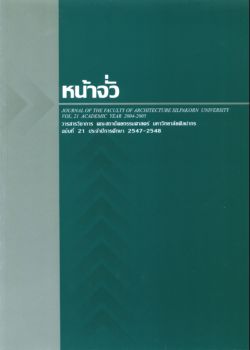เชิงช่างทางไทย : ผลสัมฤทธิ์ของการล้มสอบ ชะโงก
Keywords:
สถาปัตยกรรมไทย, เคล็ดเชิงช่างไทย, การรับรู้, Thai architecture, Modus operandi of Thai Builders, PerceptionAbstract
อัตลักษณ์ประการหนึ่งของสิ่งปลูกสร้างอย่างไทย คือการมีรูปทรงสัณฐานสอบปลายไม่เหมือนใคร ส่วนล่างของ อาคารขยายกว้างแล้วค่อยๆเรียวลงที่เบื้องบน พลอยพาให้บรรดาทัพสัมภาระหลายอย่างที่มาประกบประกอบกัน เข้าเป็นสถาปัตยกรรม เช่น เสา ฝา และอื่นๆ มีลักษณะสอบปลาย ทั้งยังตั้งอยู่ในลักษณะลัม สัมพันธ์กันไปกับการสอบ ส่วนจั่วกลับอยู่ในลักษณะชะโงก คือยอดจั่วยื่นล้ําออกมาจากส่วนล่าง
ทั้งการ ล้ม สอบ และชะโงก ล้วนเกิดจากการจงใจตั้งองค์ประกอบอาคารให้เอนเลี่ยงไปจากแกนดิ่งในอัตรา เพียงเล็กน้อย เท่าที่ผ่านมามีการวิเคราะห์ไขคําตอบของเคล็ดลับประการนี้กันว่า เพื่อสร้างความแข็งแรงให้กับโครงสร้าง อาคารเป็นหลัก ที่มองว่าเป็นการทําให้ตอบรับกับปัจจัยแวดล้อมด้านลมและฝนก็มี
ในที่นี้มองด้วยมุมต่างออกไปจากที่เคยลงความเห็นกันมา ด้วยการอิงหลักการรับรู้ทางตาเป็นพื้นฐาน mតឆ័យ สอบส่งผลให้เกิดการลวงตา ทําให้อาคารดเพรียวกว่าของจริง ส่วนการชะโงกช่วยปรับการผิดเพี้ยนอันเกิดจากการรับรู้ ทางตาที่หลังคาให้คืนสู่ภาวะปกติ ทั้งหมดนี้ร่วมก่อให้เกิดผลสัมฤทธิ์ด้านสุนทรียภาพลักษณ์สิ่งปลูกสร้างที่ประจักษ์ แก่สายตาของผู้พบเห็น เป็นความละเมียดละไมของช่างไทยที่รังสรรค์ให้งานสถาปัตยกรรมไทยถึงพร้อมด้วยความงดงามยิ่ง
Modus Operandi of Thai Builders: Resultant Effect of Tilting, Tapering, Slanting
One of the distinguishing characteristics of Thai structural forms that make them different from those found elsewhere is the tapering design. Wide at the base and tapering gradually upwards, the design necessitates all the building components, such as columns and walls, also be tapered and erected at an angle inclined relative to the tapering. The ends of the roof gable on the other hand Slant slightly forward, also at inclined angle, as it gradually rises towards the apex.This tilting tapering and slanting resulted from the intention to erect vertical building components at an angle that is slightly off perpendicular. Suppositions as to the reason behind this modus operandi are, primarily, to give stability to the structure, and responding to the local climatic elements such as Sun wind and rain.
This article takes another perspective different from the accepted suppositions and looks at it from the point of view of visual perception. Tapering gives the illusion of a building being more slender than it actually is whilst the ends of the roof gable Slanting forward helps to correct the otherwise visual discord. In essence, they combine to give the resultant aesthetic harmony to the form of the building structure in the eyes of the observer. Such refined subtlety created by Thai Builders brings added value to the appreciation of Thai architectural beauty.





